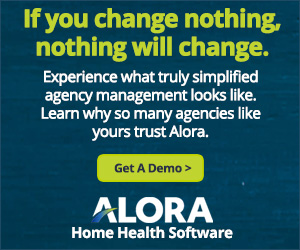
22 Jun Home Health Revenue & Documentation
How Improving Documentation can Increase Home Health Revenue
Providing safe, effective, and quality care is the hallmark of Medicare-certified home health agencies. Agencies deserve to be reimbursed for their service and hard work for their patients but inaccurate, incomplete, or missing documentation can delay and alter reimbursement, or deny the claim altogether.
Reimbursement Changes in 2022
Changes in reimbursement have been on the horizon and are scheduled to be fully implemented by January 2023. Home health agencies need to be on top of these changes and documentation should reflect these changes for maximum reimbursement and minimum denials. Ineffective documentation leaves hard-earned and deserved money on the table.
The Centers for Medicare and Medicaid Services (CMS) established a final rule to improve home care that is designed to shift payment from volume of services to a system that pays for value.
The Calendar Year 2022 (CY 2022) will see a nationwide expansion of the Home Health Value-Based Purchasing already established in 9 states to all 50 states and territories which will include Prospective Payment System and home infusion pay rate changes. During CY 2022, HHA’s will be provided with resources and training on the requirements of the expanded HHVBP without risk to payments.
Home health agencies are challenged to get up to speed on knowledge and execution of expectations of HHBVP in 2022 without any risk of revenue loss.
As of January 1, 2023, it becomes real and revenue loss, claims denial, and audit risks become possibilities for those who did not do the groundwork to learn the challenges, adapt, and train their staff accordingly.
Of the multiple moving parts of this shift to a new model of care delivery and payment, documentation remains a top priority.
A Brief History of Changes Important to Know
Since October 2000, payments to home health agencies (HHAs) covered all home health services in an HH PPS 60-day episode of care. Payment amounts for each 60-day episode were adjusted for area wage difference and case-mix patients. The case-mix criteria for adjustment included clinical, functional, and service dimensions. Payments to the HHA for the episode could increase if certain therapy visit thresholds were obtained.
In 2018. The Bipartisan Budget Act included requirements for home health payment reform which initially had an effective date of January 20, 2020. The COVID-19 pandemic derailed the complete implementation of changes. Some changes were made, but all recommended and required for home health care reform are on point to be implemented without exception on January 1, 2023.
Section 3708(f) and Section 3707 of the CARES Act were amended in March of 2020 to allow nurse practitioners (NP), physician assistants, (PA), and certified nurse specialists (CNS) to order and certify home health services and to continue to use of telehealth services provided during the pandemic. Section 409.43 (a) allows the use of telehealth if it does not replace necessary in-person care.
- Change from a 60-day episode to a 30-day payment episode
- Eliminate therapy thresholds for case-mix adjustment
- Implementation of Patient-Driven Groupings Model (PDGM)
- Nurse practitioners, clinical nurse specialists, and physician’s assistants are allowed to order and certify care
- Telehealth sessions are allowed if they do not replace F2F service
- Expanded Home Health Valued Based Model will extend to all 50 states and territories by January 1, 2022, without risk of loss of revenue.
- Changes in home infusion payment rates
- Occupational therapists can complete the initial assessments
The implementation of the Patient-Driven Groupings Model (PDGM) removed any payment incentive for providing additional or unnecessary therapy visits.
The HHVBP Model is designed to give Medicare-certified home health agencies (HHAs) incentives to give higher quality and more efficient care.
The Expanded HHVBP Model in a Nutshell
Basically, a home health agency’s performance will be measured against a set of quality measures relative to their peer’s performance. This is very important because the HHA will receive payment adjustments to their Medicare fee-for-service payments based on their performance. A home health agency’s performance in a performance year impacts payment in a later year (payment year).
A home health agency’s performance is measured using the criteria from OASIS data, completed HHCAPHPS surveys, and claims-based measures.
OASIS-based Criteria
- Improvement in Dyspnea/Dyspnea
- Patient discharged to Community
- Improvement in Management of Oral Medications/Oral Medications
- Total Normalized Composite Change in Self-Care/TNC Self-Care
- Total Normalized Composite Change in Mobility/TNC Mobility
Claims-based Criteria
- Acute Care Hospitalization During the First 60 Days of Home Health Use/ACH
- Emergency Department Use without Hospitalization During the First 60 Days of Home Health/ED Use
HHCAHPS Survey-based
- Care of Patients/Professional Care
- Communications between Providers and Patients/Communication
- Specific Care Issues/Team Discussion
- Overall rating of home health care/Overall Rating
- Willingness to recommend the agency/Willing to Recommend
Home health agencies should be aware of the requirements for the Home Health Quality reporting program (Home Health QRP).
How Do These Changes Relate to Home Health Documentation?
Whether you use home health software, mobile, or on-paper methods in your agency, accurate and complete documentation are key components to receiving appropriate compensation for the new changes.
The age-old cliché of “if it isn’t documented, it wasn’t done” is relevant here. When documentation is missing, lacks clarity, or does not support clinical needs, payments can be delayed, adjusted, or denied. Documentation must be timely, accurate, and complete for HHAs to receive prompt reimbursements and reduce denials of claims.
Putting the focus on patient needs rather than the volume of visits is one of the primary goals of the Patient-Driven Groupings Model (PDGM). Patient characteristics factor heavily into payment with this model so improving documentation of characteristics is critical for accurate reimbursement.
Clinical Documentation Improvement Programs
The implementation of a clinical documentation program (CDI) is one management tool that can significantly improve documentation to clear, concise, congruent, and complete standards. Clinical documentation starts with the referral and continues through discharge.
- Plan of Care (485)
- SOC/ROC Recertifications
- Discharge Oasis
A good CDI program will include a committed and consistent review of the following.
- Physician Orders
- Care Plans
- Visits
- Visit notes that report patient teaching and response
- Clinical Assessments
- Pay attention to low-utilization payment adjustments (LUPAs)
Documentation should be timely, consistent, and congruent. It should be complete. Staff should be trained on completing OASIS data accurately and completely and be knowledgeable about the changes with OASIS-E as certain OASIS items are used to determine the case-mix adjustment to the national, standardized 30-day pay rate.
Summary
The expanded HHVBP Model adjusts payments based on the quality of care as opposed to the number of services. Clinical documentation, coding, and billing errors can be costly to the home health agency by contributing to reimbursement issues and outcome reports. The HHVBP Model is designed so that the best-performing home health agencies receive the largest payment boost with a maximum adjustment of 5 percent. On the other hand, the worst-performing home health agencies risk a 5% payment penalty. Home health agencies should implement a clinical documentation program (CDI) as well as a staff training program to educate staff on accurate and complete data collection to optimize both patient outcomes and reimbursement for services rendered.

Alora provides agencies with the tools necessary for successful documentation. Administrators and clinicians have a partner in ALORA from a regulatory, clinical and operation standpoint. To learn more about how ALORA partners with agencies for peak performance, productivity, financial success, and compliance, click the link below to




No Comments